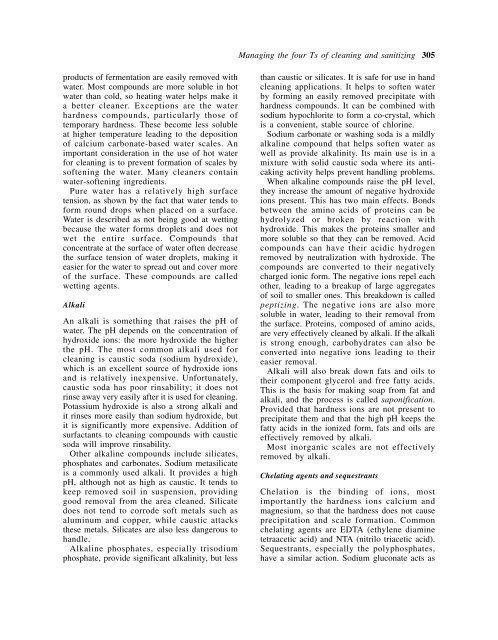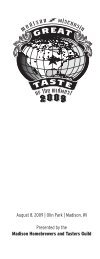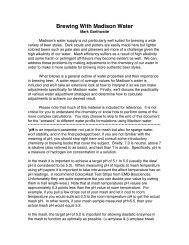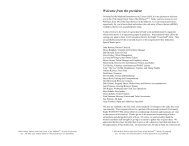THE ALCOHOL TEXTBOOK THE ALCOHOL TEXTBOOK
THE ALCOHOL TEXTBOOK THE ALCOHOL TEXTBOOK
THE ALCOHOL TEXTBOOK THE ALCOHOL TEXTBOOK
Create successful ePaper yourself
Turn your PDF publications into a flip-book with our unique Google optimized e-Paper software.
Managing the four Ts of cleaning and sanitizing 305<br />
products of fermentation are easily removed with<br />
water. Most compounds are more soluble in hot<br />
water than cold, so heating water helps make it<br />
a better cleaner. Exceptions are the water<br />
hardness compounds, particularly those of<br />
temporary hardness. These become less soluble<br />
at higher temperature leading to the deposition<br />
of calcium carbonate-based water scales. An<br />
important consideration in the use of hot water<br />
for cleaning is to prevent formation of scales by<br />
softening the water. Many cleaners contain<br />
water-softening ingredients.<br />
Pure water has a relatively high surface<br />
tension, as shown by the fact that water tends to<br />
form round drops when placed on a surface.<br />
Water is described as not being good at wetting<br />
because the water forms droplets and does not<br />
wet the entire surface. Compounds that<br />
concentrate at the surface of water often decrease<br />
the surface tension of water droplets, making it<br />
easier for the water to spread out and cover more<br />
of the surface. These compounds are called<br />
wetting agents.<br />
Alkali<br />
An alkali is something that raises the pH of<br />
water. The pH depends on the concentration of<br />
hydroxide ions: the more hydroxide the higher<br />
the pH. The most common alkali used for<br />
cleaning is caustic soda (sodium hydroxide),<br />
which is an excellent source of hydroxide ions<br />
and is relatively inexpensive. Unfortunately,<br />
caustic soda has poor rinsability; it does not<br />
rinse away very easily after it is used for cleaning.<br />
Potassium hydroxide is also a strong alkali and<br />
it rinses more easily than sodium hydroxide, but<br />
it is significantly more expensive. Addition of<br />
surfactants to cleaning compounds with caustic<br />
soda will improve rinsability.<br />
Other alkaline compounds include silicates,<br />
phosphates and carbonates. Sodium metasilicate<br />
is a commonly used alkali. It provides a high<br />
pH, although not as high as caustic. It tends to<br />
keep removed soil in suspension, providing<br />
good removal from the area cleaned. Silicate<br />
does not tend to corrode soft metals such as<br />
aluminum and copper, while caustic attacks<br />
these metals. Silicates are also less dangerous to<br />
handle.<br />
Alkaline phosphates, especially trisodium<br />
phosphate, provide significant alkalinity, but less<br />
than caustic or silicates. It is safe for use in hand<br />
cleaning applications. It helps to soften water<br />
by forming an easily removed precipitate with<br />
hardness compounds. It can be combined with<br />
sodium hypochlorite to form a co-crystal, which<br />
is a convenient, stable source of chlorine.<br />
Sodium carbonate or washing soda is a mildly<br />
alkaline compound that helps soften water as<br />
well as provide alkalinity. Its main use is in a<br />
mixture with solid caustic soda where its anticaking<br />
activity helps prevent handling problems.<br />
When alkaline compounds raise the pH level,<br />
they increase the amount of negative hydroxide<br />
ions present. This has two main effects. Bonds<br />
between the amino acids of proteins can be<br />
hydrolyzed or broken by reaction with<br />
hydroxide. This makes the proteins smaller and<br />
more soluble so that they can be removed. Acid<br />
compounds can have their acidic hydrogen<br />
removed by neutralization with hydroxide. The<br />
compounds are converted to their negatively<br />
charged ionic form. The negative ions repel each<br />
other, leading to a breakup of large aggregates<br />
of soil to smaller ones. This breakdown is called<br />
peptizing. The negative ions are also more<br />
soluble in water, leading to their removal from<br />
the surface. Proteins, composed of amino acids,<br />
are very effectively cleaned by alkali. If the alkali<br />
is strong enough, carbohydrates can also be<br />
converted into negative ions leading to their<br />
easier removal.<br />
Alkali will also break down fats and oils to<br />
their component glycerol and free fatty acids.<br />
This is the basis for making soap from fat and<br />
alkali, and the process is called saponification.<br />
Provided that hardness ions are not present to<br />
precipitate them and that the high pH keeps the<br />
fatty acids in the ionized form, fats and oils are<br />
effectively removed by alkali.<br />
Most inorganic scales are not effectively<br />
removed by alkali.<br />
Chelating agents and sequestrants<br />
Chelation is the binding of ions, most<br />
importantly the hardness ions calcium and<br />
magnesium, so that the hardness does not cause<br />
precipitation and scale formation. Common<br />
chelating agents are EDTA (ethylene diamine<br />
tetraacetic acid) and NTA (nitrilo triacetic acid).<br />
Sequestrants, especially the polyphosphates,<br />
have a similar action. Sodium gluconate acts as









